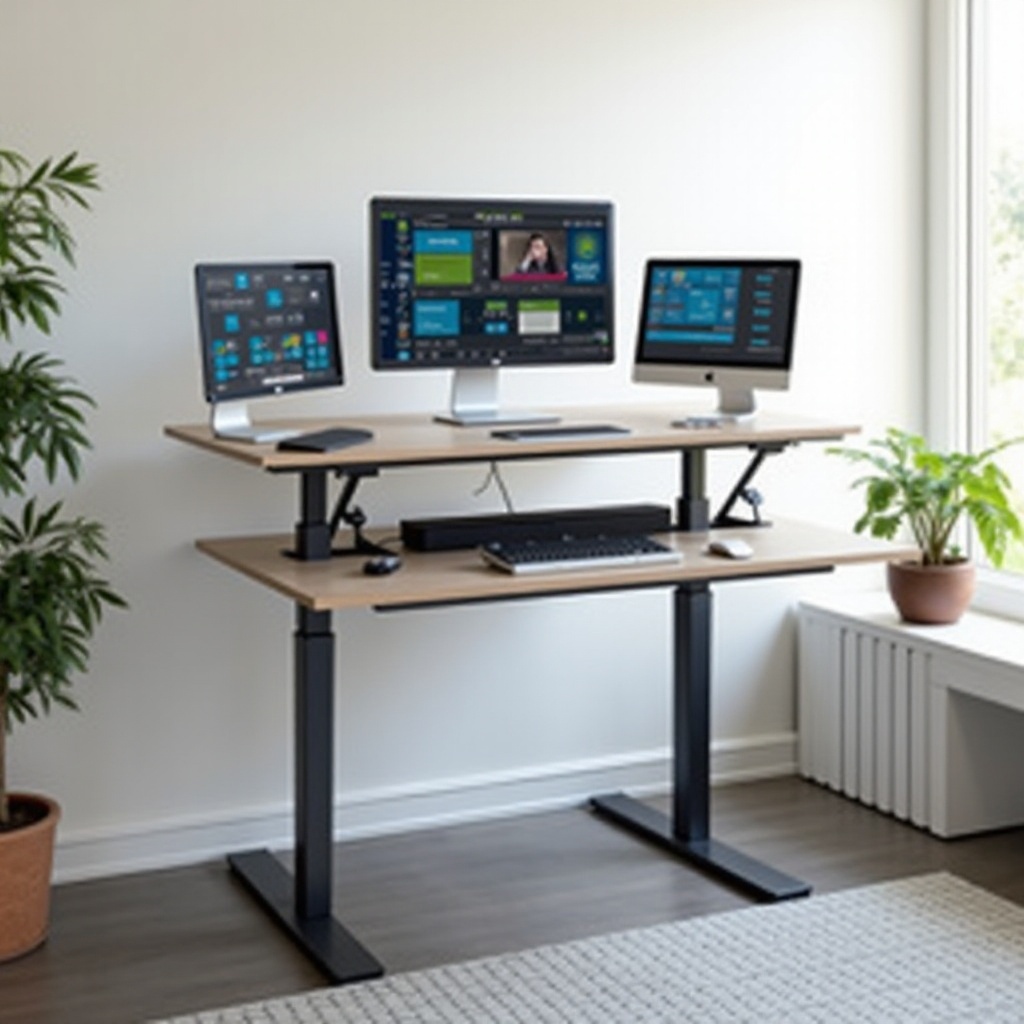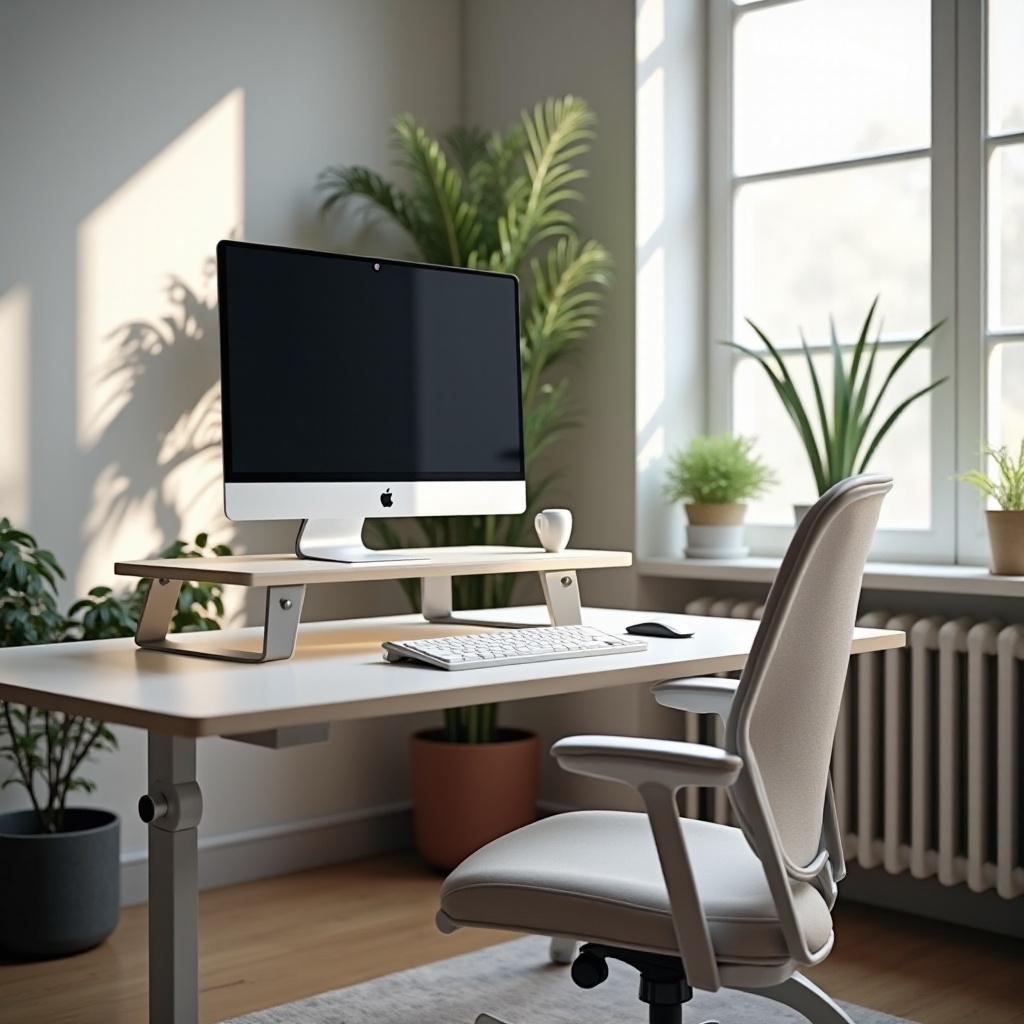Introduction
Working long hours at a computer can be exhausting. But with advancements in technology and ergonomic solutions, it has become easier to create a more comfortable and productive work environment. One innovative way to enhance your workspace is by integrating a TV above your standing desk with computers. This setup not only adds convenience but also boosts productivity.
In this guide, we’ll explore how to effectively integrate a TV into your standing desk setup. We’ll discuss the benefits, considerations for choosing the right TV, ergonomic placement tips, and practical uses to help you make the most out of your workspace.

Benefits of Adding a TV to Your Standing Desk Setup
Integrating a TV into your standing desk setup comes with a host of advantages. Here’s a closer look at some of these benefits:
-
Enhanced Multitasking:
A TV above your standing desk allows you to multitask effectively. You can work on your computer while keeping an eye on important updates or attending virtual meetings on the TV screen. This setup can be particularly beneficial for professionals who need to stay updated with real-time data or follow along with online training sessions. -
Improved Ergonomics:
Positioning a TV slightly above your primary monitor can help improve ergonomics. You can adjust your viewing angle, thereby reducing neck strain and promoting better posture. This is especially beneficial when using a standing desk, as it encourages movement and reduces the risk of musculoskeletal issues. -
Increased Productivity:
Having an additional screen can increase productivity by eliminating the need to switch between multiple windows constantly. It allows for a seamless workflow, as you can reference documents, watch instructional videos, or monitor live feeds without interrupting your core tasks.

Choosing the Right TV for Your Workspace
To fully benefit from integrating a TV into your standing desk setup, it’s crucial to choose a TV that complements your workspace and meets your needs. Here are some factors to consider:
-
Size and Resolution:
Opt for a TV that is appropriately sized for your workspace. A screen that is too large may dominate your desk area, while a smaller screen might not provide the enhanced visibility you need. Ideally, a TV between 32 to 43 inches should work well for most standing desk setups. Additionally, choose a TV with a high resolution (at least 1080p) to ensure clear and sharp images. -
Mounting Options:
Select a TV with VESA mount compatibility, allowing you to securely mount it to the wall or a monitor arm above your desk. Ensure the mounting hardware you use can support the weight and size of the TV. -
Connectivity:
Check the connectivity options available on the TV. It should have multiple HDMI ports, USB ports, and wireless connectivity options like Bluetooth and Wi-Fi. This ensures you can connect it to your computer and other peripherals with ease. -
Smart Features:
A Smart TV with built-in streaming apps and wireless connectivity can be highly beneficial. You can access online resources, stream content, and even conduct virtual meetings without needing additional devices.

Ergonomic Considerations for TV Placement
Proper placement of your TV is essential for maintaining an ergonomic workspace. Here are some tips to ensure your TV is positioned comfortably above your standing desk:
-
Optimal Viewing Height:
Mount the TV at eye level when you are standing. The center of the TV screen should be at or just below eye level, ensuring a comfortable viewing angle without the need to tilt your head excessively. -
Distance from Your Eyes:
Maintain an appropriate distance between your eyes and the screen. As a general rule, position the TV about 1.5 to 2 times the diagonal size of the screen away from you. This ensures you can view the content clearly without straining your eyes. -
Adjustable Mounts:
Consider using adjustable mounts that allow you to tilt, swivel, and adjust the TV’s height as needed. This flexibility ensures that you can fine-tune the positioning for optimal comfort and visibility. -
Lighting Considerations:
Ensure that the TV is positioned to avoid glare from windows or overhead lighting. Use curtains or blinds to control natural light, and consider using an anti-glare screen protector if needed.
Setting Up Your Standing Desk with Computers and TV
Once you’ve selected the right TV and determined its optimal placement, it’s time to set up your standing desk with computers and TV:
-
Mount the TV:
Securely mount the TV using the appropriate mounting hardware. Ensure it is at the correct height and angle for comfortable viewing. -
Arrange Your Computer Monitors:
Position your primary computer monitor(s) below the TV and at an ergonomic height. Align the top of your monitor with your eye level when standing. -
Manage Cables:
Use cable management solutions such as clips, sleeves, and cable organizers to keep cables out of the way. This not only maintains a clean workspace but also prevents trip hazards. -
Connect Devices:
Connect your computer and other peripherals to the TV. Use HDMI cables for a reliable connection, and consider using a wireless or Bluetooth keyboard and mouse for added flexibility. -
Test the Setup:
Once everything is connected, test the setup to ensure that the TV and computer monitors are functioning properly. Make any necessary adjustments to the placement or settings.
Practical Uses and Productivity Tips
Now that you have your TV mounted above your standing desk and computers set up, let’s explore some practical uses and productivity tips:
-
Virtual Meetings:
Use the TV for video conferencing, freeing up your computer monitors for taking notes and accessing relevant documents during meetings. -
Reference Material:
Display reference materials, live data feeds, or instructional videos on the TV while you work on your computer. This enhances multitasking and keeps you informed. -
Break Time:
Take short breaks by watching news updates, tutorials, or your favorite content on the TV. This can help you relax and recharge without leaving your workspace. -
Digital Signage:
Use the TV for digital signage, displaying important announcements, schedules, or reminders for yourself or your team.
Conclusion
Integrating a TV above your standing desk with computers can transform your workspace into a more productive and ergonomic environment. By carefully selecting the right TV, positioning it for comfort, and effectively setting up your workspace, you can enjoy the benefits of enhanced multitasking, improved ergonomics, and increased productivity.
Whether you’re using the TV for virtual meetings, reference materials, or a blend of work and leisure, this setup can make your workday more efficient and enjoyable. Take the time to optimize your workspace, and you’ll be well on your way to a more dynamic and effective work environment.
Frequently Asked Questions
How high should the TV be mounted above the standing desk?
The TV should be mounted at eye level when you are standing. The center of the TV screen should be at or just below eye level, ensuring a comfortable viewing angle without excessive head tilting.
Can a TV replace multiple computer monitors in a standing desk setup?
While a TV can provide additional screen space, it may not fully replace multiple computer monitors. Multiple monitors offer more flexibility for complex multitasking, whereas a TV is better suited for viewing content, video conferencing, and reference materials.
What are the best practices for managing cables with this setup?
1. Use cable management clips, sleeves, and organizers to keep cables tidy and out of the way. 2. Route cables along the edges of the desk to prevent clutter and trip hazards. 3. Consider using wireless peripherals to minimize cable usage and maintain a clean workspace.